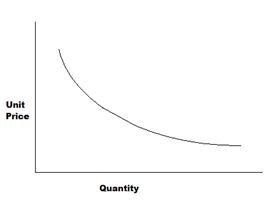(Rewrite) Tags: Visual edit apiedit |
(→See Also: Minor) Tags: Visual edit apiedit |
||
| Line 19: | Line 19: | ||
== See Also == |
== See Also == |
||
| + | [[Crowdfunding Bank]], one of the next steps for a VIAAC, which can evolve out of a consumer cooperative. |
||
| − | [[Crowdfunding Bank]] |
||
| − | [[Local Production Prioritisation]], one of the next steps |
+ | [[Local Production Prioritisation]], one of the next steps for a VIAAC. |
Latest revision as of 21:11, 5 September 2015
Introduction[]
As with production of goods, in procurement of goods, the quantity and price are inversely related. The effect is hardly noticed by the average person, since their individual buying power affords them access to only the final links in a supply chain. However, large companies (with the strongest buying power) purchase these goods at lower costs and then redistribute them in order to capitalize on the individuals' lack of buying power.

The Price Curve Of Bulk Purchasing
Buying power determines how far up the supply chain one may go, before capitalists add their value chain to the price and taxes get charged on the additional links. The further a supply chain is extended, the more "value" must be added on artificially. Because the economy must grow continuously, this means that as long as the business of an industry is doing well, the supply chain of that industry is being increasingly capitalized.
Consumer Cooperatives[]

Price Increases with extended supply chains
Groups of people may organize themselves to increase the purchasing and bargaining power they have for personal consumption. An organization formed for this purpose is called a consumer cooperative. The consumer cooperative increases the savings of the cooperative's members.
This ‘savings’ margin will fluctuate from product to product, but will never be less than zero, meaning that communal purchasing is certainly beneficial. Since goods bought in bulk are not necessarily packaged for retail, there is a reduction in waste from capitalist packaging and bundling.
Data Collection[]
Bulk purchasing presents an ideal point for collecting data for the VIAAC's DARMA system. The cooperative already needs to know how much of each thing to buy, and knowing just the quantities, datetimes, and identifiers (UPC, SKU) of the goods is enough to start keeping a record of demand and building a flow network model of the VIAAC. Initially, very little of this data will be structured. The first steps should be to classify the individual products, in order to abstract the network and make it more useful in general analyses.
With the cooperative collecting consumption data, they can better predict how much needs to be procured. Because exact quantities would be accounted for, there should be an immediate decline in the amount of resources being procured needlessly or speculatively. This reduction in wastage as well as cost of resources means the further increase of the community sustainability margin. Once the products purchased are abstracted, the variety of products may be reduced, if the buyers are indifferent to the change and it further increases the buying power of the cooperative.
See Also[]
Crowdfunding Bank, one of the next steps for a VIAAC, which can evolve out of a consumer cooperative.
Local Production Prioritisation, one of the next steps for a VIAAC.